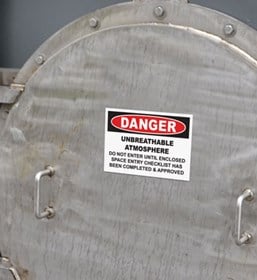Resource Navigation
Confined Space Hazard Awareness for Everybody
03
February,
2023
2 MINUTE READ

Confined spaces and their hazards are not limited to the employees working in these spaces. More often than not, the rescuers are just as likely to be injured or killed when rendering aid. And many confined space fatalities are among the rescuers, according to a report by NIOSH.
Who's at Risk and Why?
Generally, when someone is in trouble, most people automatically act, trying to render aid. This includes coworkers, emergency workers (firefighters and EMTs), and citizens. Each of the following examples illustrate the dangers of confined spaces that can affect anyone.
In Middletown, Ohio, three firefighters nearly perished when attempting to rescue a worker who fell unconscious when inspecting a manhole.
In Liberty Township, Indiana, a citizen and two firefighters were incapacitated when attempting to rescue a worker who collapsed in a 10-foot deep pit.
In Tarrytown, New York, a firefighter attempted to rescue a worker who fell unconscious when working in a manhole. Both the worker and firefighter perished from exposure to toxic gasses.
(Source: OH&S Magazine, February 2011).

In all three cases, the individuals who attempted rescue were either incapacitated or killed as a result of atmospheric hazards in the confined spaces. In these cases, the proper training and communication of the potential hazards could have prevented these deaths. While it is unlikely that the average citizen will ever undergo confined space training, clear and impactful safety messages can help to ensure that everybody knows the risks surrounding confined spaces Duralabel line of DuraLabel printers and labeling supplies can help you print custom warnings and safety messages to increase hazard awareness for workers, emergency responders, and citizens.
What's Been Done
Two OSHA standards, one for general industry and one for construction work, have been created in an effort to improve confined space safety for workers and rescuers. Both 1910.146 (General Industry) and 1926 Subpart AA (Construction) have specific requirements designed to keep people safe. Employers are required to:
- Have a written permit program in place for "permit-required" confined spaces
- Provide training
- Provide an attendant to monitor workers who enter "permit-required" confined spaces
- Provide testing, monitoring, ventilation, and communication equipment
- Provide the appropriate Personal Protective Equipment (PPE)
- Create a rescue and emergency service plan
- Prevent rescue attempts by unauthorized personnel
These standards form a robust set of tools that can reduce safety hazards and prevent confined space fatalities, and OSHA diligently works to enforce these standards. Learn more about confined spaces and how to stay safe with the Confined Spaces Best Practice Guide by Duralabel.
What You Can Do
In the construction industry alone, OSHA estimates that full compliance with confined space rules will prevent 96% of confined space injuries and fatalities. The benefits of confined space compliance, however, are not limited to construction. Agriculture, mining, food processing, wineries, breweries, and even grocery stores have confined spaces that can place people in harm's way.
Make safety a daily part of your workplace culture. Have your safety manager instill a culture of safety through meetings, regular training, and recognition for safe work behavior. Teach workers to recognize safety issues and speak up to stop accidents before they happen. Support your safety program with safety signs that warn people of confined spaces and their hazards. Take control with DuraLabel Toro and create custom, bold signs that help keep both workers and rescuers safe. Compliance and safety in confined space is at your fingertips. Download our free confined space guide today.
RELATED RESOURCES

Confined Space Hazards 101: The Basics
A confined space consists of any one of the following characteristics: Limited openings for entry and exit ...
Read
Confined Spaces: How to Satisfy OSHA Compliance
While you may think of any small area as a confined space, the OSHA definition is slightly different. It is ...
Read
Tunnel Construction Safety
I'm in awe of tunnels. How do they construct giant tubes under mountains, lakes, rivers and oceans? How long ...
Read.png)


